Book contents
- Good Thinking
- Good Thinking
- Copyright page
- Dedication
- Contents
- Figures
- Tables
- Preface
- Part I
- Part II
- Eight Into the Weeds of Logic – How It’s Done
- Nine Into the Weeds of Moral Judgment – How It’s Done
- Ten Into the Weeds of Analogical Reasoning – How It’s Done
- Eleven Into the Weeds of Scientific Reasoning – How It’s Done
- Twelve Into the Weeds of Rational Decision-Making – How It’s Done
- Thirteen Into the Weeds of Game Theory – How It’s Done
- Fourteen Into the Weeds of Problem-Solving – How It’s Done
- Appendix A Answers to Insight Problems
- Answer Key to Quizzes
- Notes
- Index
Twelve - Into the Weeds of Rational Decision-Making – How It’s Done
from Part II
Published online by Cambridge University Press: 18 February 2021
- Good Thinking
- Good Thinking
- Copyright page
- Dedication
- Contents
- Figures
- Tables
- Preface
- Part I
- Part II
- Eight Into the Weeds of Logic – How It’s Done
- Nine Into the Weeds of Moral Judgment – How It’s Done
- Ten Into the Weeds of Analogical Reasoning – How It’s Done
- Eleven Into the Weeds of Scientific Reasoning – How It’s Done
- Twelve Into the Weeds of Rational Decision-Making – How It’s Done
- Thirteen Into the Weeds of Game Theory – How It’s Done
- Fourteen Into the Weeds of Problem-Solving – How It’s Done
- Appendix A Answers to Insight Problems
- Answer Key to Quizzes
- Notes
- Index
Summary
Bayes Rule is the dominant decision-making framework across a number of disciplines, including medical science, economics, psychology, and physics. It is a powerful tool for making decisions under conditions of uncertainty. The point of Bayesian decision-making is to ground our beliefs in actual facts and data. We have a belief, new information comes along, and we update our belief based on that information. That is the way that we ensure we have a head full of true beliefs that are grounded in evidence rather than prejudice.
We are always developing and updating beliefs from a place of uncertainty, which means that most of our beliefs are probabilistic. For example, the weather report says that the chance it will rain today is low, so that is what we believe. But then we check the sky, see rainclouds, and update our belief based on that observation. Now we believe there is a high probability that it will rain today. We updated our belief based on objective evidence. We behaved rationally.
- Type
- Chapter
- Information
- Good ThinkingSeven Powerful Ideas That Influence the Way We Think, pp. 262 - 278Publisher: Cambridge University PressPrint publication year: 2021
- 1
- Cited by



